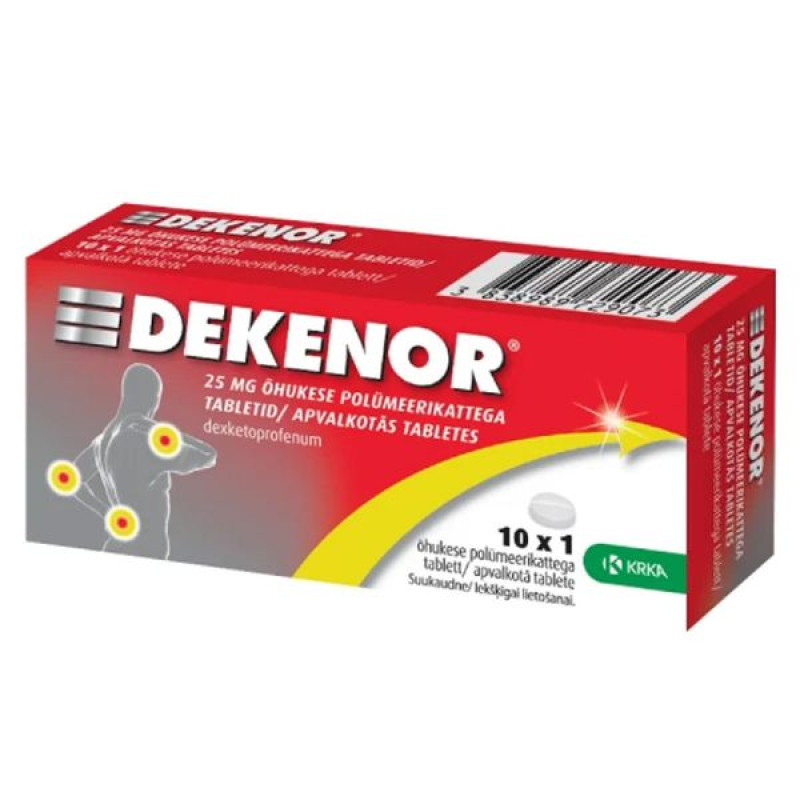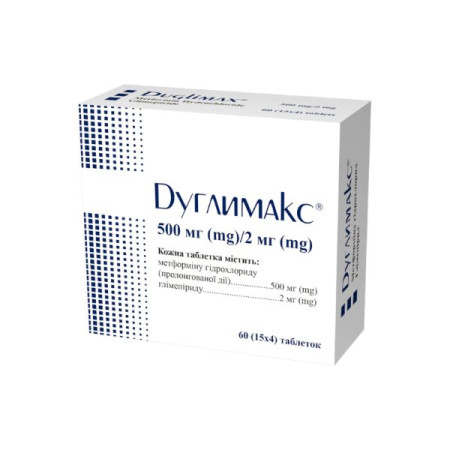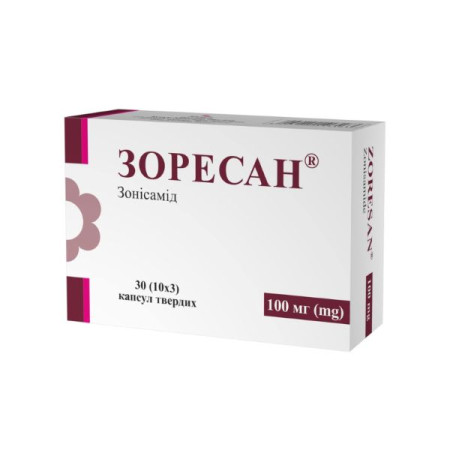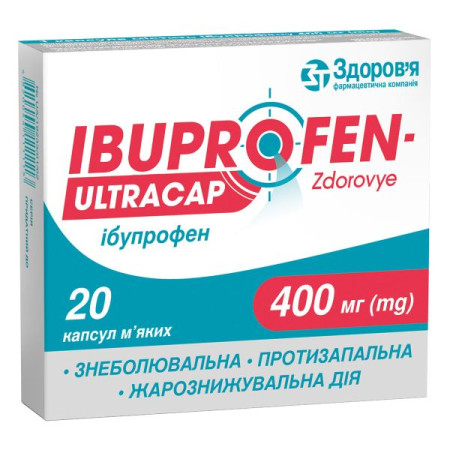Decenor film-coated tablets 25 mg blister No. 10

Instructions for use: Dekenor film-coated tablets 25 mg, blister pack No. 10
Composition
active ingredient: dexketoprofen;
1 tablet contains 25 mg of dexketoprofen (as dexketoprofen trometamol);
excipients: microcrystalline cellulose, croscarmellose sodium, corn starch, colloidal anhydrous silicon dioxide, magnesium stearate;
film coating: coating mixture: hypromellose, macrogol 6000, propylene glycol, titanium dioxide (E 171).
Dosage form
Film-coated tablets.
Main physicochemical properties: white or almost white, round, biconvex, film-coated tablets, with a score on one side. The tablet can be divided into two equal doses.
Pharmacotherapeutic group
Anti-inflammatory and antirheumatic agents. Propionic acid derivatives. ATX code M01A E17.
Pharmacological properties
Pharmacodynamics.
Dexketoprofen trometamol is the tromethamine salt of S-(+)-2-(3-benzoylphenyl)propionic acid, which has analgesic, anti-inflammatory and antipyretic effects and belongs to the group of non-steroidal anti-inflammatory drugs (NSAIDs).
Mechanism of action
The mechanism of action of nonsteroidal anti-inflammatory drugs is associated with a decrease in prostaglandin synthesis by inhibiting cyclooxygenase (COX).
In particular, the conversion of arachidonic acid to cyclic endoperoxides PGG2 and PGH2 is inhibited, from which prostaglandins PGE1, PGE2, PGF2α, PGD2 are formed, as well as prostacyclin PGI2 and thromboxanes (TxA2 and TxB2). In addition, inhibition of prostaglandin synthesis may affect other inflammatory mediators, such as kinins, which may also indirectly affect the main effect of the drug.
Pharmacodynamic action
The inhibitory effect of dexketoprofen on the COX-1 and COX-2 isoenzymes has been demonstrated in animals and humans.
Clinical efficacy and safety
Clinical studies on various types of pain have demonstrated the effective analgesic effect of dexketoprofen, which develops 30 minutes after using the drug and lasts 4–6 hours.
Pharmacokinetics.
Absorption
After oral administration of dexketoprofen trometamol, the maximum plasma concentration (Cmax) is reached after 30 min (15–60 min).
When dexketoprofen is taken with food, the area under the concentration-time curve (AUC) does not change, but the Cmax value decreases and the absorption rate decreases (tmax increases).
Distribution
The half-life and elimination half-life of dexketoprofen trometamol are 0.35 and 1.65 hours, respectively. Similar to other drugs with a high degree of binding to plasma proteins (99%), the volume of distribution of dexketoprofen is less than 0.25 l/kg. Pharmacokinetic studies of multiple administration of the drug have shown that after the last administration of dexketoprofen trometamol, the AUC values do not differ from those after its single administration, which proves the absence of cumulation of the drug.
Biotransformation and excretion
After administration of dexketoprofen trometamol, only the S-(+) optical isomer is detected in the urine, indicating that the drug is not transformed into the R-(–) optical isomer in the human body. The main route of elimination of dexketoprofen is mainly through conjugation with glucuronic acid and subsequent renal excretion.
Indication
For the symptomatic treatment of mild to moderate pain, such as musculoskeletal pain, menstrual pain (dysmenorrhea), toothache.
Contraindication
The drug Dekenor® is contraindicated in the following cases:
hypersensitivity to dexketoprofen, any other non-steroidal anti-inflammatory drug (NSAID) or to the excipients of the drug;
if substances with a similar effect, such as acetylsalicylic acid or other NSAIDs, provoke the patient to develop asthma attacks, bronchospasm, acute rhinitis or cause the development of nasal polyps, urticaria or angioedema;
if the patient has experienced photoallergic and phototoxic reactions during treatment with ketoprofen or fibrates;
history of gastrointestinal bleeding or perforation related to previous NSAID therapy;
active phase of peptic ulcer/gastrointestinal bleeding or history of gastrointestinal bleeding, peptic ulcer, perforation;
chronic dyspepsia;
other bleeding in the active phase or increased bleeding;
Crohn's disease or ulcerative colitis;
severe heart failure;
moderate or severe renal impairment (creatinine clearance ≤ 59 ml/min);
severe liver dysfunction (10–15 points on the Child-Pugh scale);
hemorrhagic diathesis and other blood clotting disorders;
severe dehydration caused by vomiting, diarrhea, or insufficient fluid intake;
Third trimester of pregnancy and breastfeeding (see section "Use during pregnancy or breastfeeding").
Interaction with other medicinal products and other types of interactions
The following drug interactions generally characterize NSAIDs.
Other NSAIDs, including selective COX-2 inhibitors and salicylates in high doses (≥3 g/day): with the simultaneous use of several NSAIDs, the risk of gastrointestinal ulcers and bleeding increases due to their mutual enhancement of action.
Anticoagulants: NSAIDs enhance the effect of anticoagulants, such as warfarin (see section "Special warnings and precautions for use"), due to the high degree of binding of dexketoprofen to blood plasma proteins, as well as inhibition of platelet function and damage to the gastric and duodenal mucosa. If concomitant use is necessary, it should be carried out under close medical supervision with monitoring of relevant laboratory parameters.
Heparin: increased risk of bleeding (due to inhibition of platelet function and damage to the gastric and duodenal mucosa). If concomitant use is necessary, it should be carried out under close medical supervision with monitoring of relevant laboratory parameters.
Corticosteroids: increased risk of gastrointestinal ulcers and bleeding (see section "Special warnings and precautions for use").
Lithium (data exist for several NSAIDs): NSAIDs increase the level of lithium in the blood, which can lead to intoxication (reduced renal excretion of lithium). Therefore, when starting dexketoprofen, when adjusting the dose or discontinuing the drug, it is necessary to determine the level of lithium in the blood.
Methotrexate in high doses (at least 15 mg per week): due to the decrease in renal clearance of methotrexate against the background of the use of NSAIDs, its hematological toxicity is generally increased.
Hydantoin derivatives and sulfonamides: possible increased toxicity of these substances.
Concomitant use requires caution
Diuretics, angiotensin-converting enzyme (ACE) inhibitors, antibacterial aminoglycosides and angiotensin II receptor antagonists (ARA II): dexketoprofen reduces the effectiveness of diuretics and other antihypertensive agents. In some patients with impaired renal function (for example, in cases of dehydration or in the elderly), the use of COX-inhibiting agents, concomitant use with ACE inhibitors, ARA II or antibacterial aminoglycosides may worsen renal function, which is usually reversible. When using dexketoprofen together with any diuretic, it is necessary to ensure that the patient is not dehydrated, and at the beginning of treatment it is necessary to monitor renal function (see section "Special instructions").
Methotrexate in low doses (less than 15 mg per week): due to the decrease in renal clearance of methotrexate against the background of the use of NSAIDs, its hematological toxicity in general increases. In the first weeks of simultaneous use, it is necessary to perform a complete blood count every week. Even with a slight impairment of renal function, as well as in elderly patients, treatment should be carried out under strict medical supervision.
Pentoxifylline: there is a risk of bleeding. It is necessary to increase monitoring and check the bleeding time more frequently.
Zidovudine: There is a risk of increased toxicity to red blood cells due to effects on reticulocytes, leading to severe anemia after the first week of NSAID use. Blood tests and reticulocyte counts should be performed 1–2 weeks after starting NSAID use.
Sulfonylureas: NSAIDs can enhance the hypoglycemic effect of sulfonylureas by displacing them in their binding to plasma proteins.
Possible interactions should be considered when using such agents.
Beta-blockers: NSAIDs can weaken their antihypertensive effect by inhibiting prostaglandin synthesis.
Cyclosporine and tacrolimus: possible increase in nephrotoxicity due to the effect of NSAIDs on renal prostaglandins. Renal function should be monitored during combination therapy.
Thrombolytic agents: increased risk of bleeding.
Antiplatelet agents and selective serotonin reuptake inhibitors: increased risk of gastrointestinal bleeding (see section "Special warnings and precautions for use").
Probenecid: an increase in dexketoprofen plasma concentrations is possible, which is probably due to inhibition of tubular secretion and conjugation of the drug with glucuronic acid and requires dose adjustment of dexketoprofen.
Cardiac glycosides: NSAIDs can increase the concentration of glycosides in the blood plasma.
Mifepristone: There is a theoretical possibility that the efficacy of mifepristone may be reduced by prostaglandin synthetase inhibitors. Some data suggest that the use of NSAIDs on the day of prostaglandin administration does not adversely affect the effect of mifepristone or prostaglandin on cervical ripening or uterine contractility and does not reduce the clinical efficacy of the method of medical abortion.
Quinoline antibiotics: Animal studies have shown that the use of quinolone derivatives in high doses in combination with NSAIDs increases the risk of seizures.
Tenofovir: Concomitant use with NSAIDs may increase blood urea nitrogen and creatinine concentrations. Renal function should be monitored closely to monitor for potential cumulative effects on renal function.
Pemetrexed: Concomitant use with NSAIDs may decrease the elimination of pemetrexed, therefore caution should be exercised when prescribing high doses of NSAIDs. In patients with mild to moderate renal impairment (creatinine clearance 45-79 ml/min), concomitant use of pemetrexed with high-dose NSAIDs should be avoided for 2 days before, on the day of, and for 2 days after pemetrexed administration.
Application features
Use with caution in patients with a history of allergic conditions.
The use of Dekenor® in combination with other NSAIDs, including selective COX-2 inhibitors, should be avoided.
Adverse reactions can be reduced by using the lowest effective dose for the shortest time necessary to improve the condition (see section “Method of administration and dosage” and information on gastrointestinal and cardiovascular risks below).
Gastrointestinal safety
Gastrointestinal bleeding, ulceration or perforation, in some cases fatal, have been reported with all NSAIDs at various stages of treatment, regardless of the presence of warning symptoms or a history of serious gastrointestinal disease. If gastrointestinal bleeding or ulceration occurs during therapy, Dekenor® should be discontinued.
The risk of gastrointestinal bleeding, ulceration or perforation increases with increasing NSAID dose in patients with a history of ulcer, especially complicated by bleeding or perforation (see section "Contraindications"), as well as in elderly patients.
NSAIDs should be prescribed with caution to patients with a history of gastrointestinal diseases (ulcerative colitis, Crohn's disease), as there is a risk of their exacerbation (see section "Adverse reactions").
Before starting the use of dexketoprofen, as with all NSAIDs, patients with a history of esophagitis, gastritis and/or peptic ulcer disease should be sure that these diseases are in remission. In patients with existing symptoms of gastrointestinal pathology and with a history of gastrointestinal diseases, the condition of the gastrointestinal tract should be monitored for possible disorders, especially gastrointestinal bleeding, during the use of the drug.
Combination therapy with protective agents, such as misoprostol or proton pump inhibitors, may be appropriate for such patients and for patients taking low-dose acetylsalicylic acid or other agents that increase the risk of gastrointestinal adverse reactions (see section “Interaction with other medicinal products and other forms of interaction”).
Patients, especially the elderly, who have a history of adverse reactions from the digestive tract, should notify their doctor of all unusual symptoms related to the digestive system, in particular gastrointestinal bleeding, especially in the initial stages of treatment.
Caution should be exercised when prescribing the drug to patients who are concomitantly taking agents that increase the risk of ulceration or bleeding, such as oral corticosteroids, anticoagulants (e.g. warfarin), selective serotonin reuptake inhibitors or antiplatelet agents such as acetylsalicylic acid (see section "Interaction with other medicinal products and other types of interactions").
Elderly patients
Elderly patients have an increased frequency of adverse reactions to NSAIDs, especially gastrointestinal bleeding and perforation, sometimes fatal (see section 4.2). Treatment of such patients should be initiated at the lowest possible dose.
Kidney safety
The drug should be prescribed with caution to patients with impaired renal function, as well as to patients with arterial hypertension and/or congestive heart failure, since they may experience deterioration of renal function, fluid retention in the body and the appearance of edema while taking NSAIDs. Due to the increased risk of nephrotoxicity, the drug should be used with caution in patients treated with diuretics, as well as in patients who may develop hypovolemia.
Adequate fluid intake should be ensured during therapy to prevent dehydration and the associated increase in renal toxicity.
Like all NSAIDs, the drug is capable of increasing the level of urea nitrogen and creatinine in the blood plasma. Like other prostaglandin synthesis inhibitors, it can cause adverse reactions from the kidneys, which can lead to glomerulonephritis, interstitial nephritis, papillary necrosis, nephrotic syndrome and acute renal failure.
Renal impairment is more common in elderly patients (see section 4.2).
Liver safety
Caution should be exercised when prescribing the drug to patients with impaired liver function. Like other NSAIDs, the drug may cause a temporary slight increase in some liver function tests, as well as a significant increase in the level of aspartate aminotransferase (AST) and alanine aminotransferase (ALT). If these values increase, treatment should be discontinued.
Liver function disorders most often occur in elderly patients (see section "Method of administration and dosage").
Patients with arterial hypertension and/or mild to moderate congestive heart failure should be under close medical supervision. Particular caution should be exercised when treating patients with a history of heart disease, in particular with episodes of heart failure, since the risk of heart failure increases with the use of the drug due to possible fluid retention in the body and the appearance of edema during NSAID therapy.
According to available clinical and epidemiological data, the use of some NSAIDs, especially at high doses and over a long period, is associated with a small increased risk of arterial thrombotic events such as myocardial infarction or stroke. There is insufficient data to exclude such a risk with dexketoprofen.
Therefore, in the case of arterial hypertension, congestive heart failure, confirmed ischemic heart disease, peripheral arterial and/or cerebrovascular diseases, dexketoprofen should be used only after careful assessment of the patient's condition. The same applies to the initiation of long-term treatment in patients with risk factors for cardiovascular disease, such as arterial hypertension, hyperlipidemia, diabetes mellitus, smoking.
All non-selective NSAIDs are capable of reducing platelet aggregation and increasing bleeding time by inhibiting prostaglandin synthesis. Therefore, patients taking dexketoprofen concomitantly with drugs that affect hemostasis (e.g. warfarin, other coumarins or heparins) require close monitoring (see section "Interaction with other medicinal products and other forms of interaction").
Cardiovascular system dysfunction most often occurs in elderly patients (see section "Method of administration and dosage").
Skin reactions
There have been very rare reports of serious skin reactions (some fatal) with NSAIDs, including exfoliative dermatitis, Stevens-Johnson syndrome and toxic epidermal necrolysis. Patients are at greatest risk at the start of treatment, with most occurring within the first month of treatment. If skin rash, signs of mucosal involvement or other signs of hypersensitivity occur, Dekenor® should be discontinued.
Other information
Particular caution should be exercised when treating patients:
with congenital disorders of porphyrin metabolism (e.g. acute intermittent porphyria);
with dehydration;
immediately after radical surgery.
If long-term therapy with dexketoprofen is necessary, liver and kidney function should be regularly checked, as well as blood tests.
Severe allergic reactions (e.g. anaphylactic shock) have been observed very rarely. At the first signs of hypersensitivity reactions, the use of Dekenor® should be discontinued. Depending on the symptoms, any treatment procedures should be initiated by healthcare professionals.
Patients suffering from asthma attacks in combination with chronic rhinitis, chronic sinusitis and/or nasal polyposis are more prone to allergic reactions when using acetylsalicylic acid or other NSAIDs. The use of the drug may provoke asthma attacks or bronchospasm, especially in patients with a history of allergic reactions to acetylsalicylic acid or other NSAIDs (see section "Contraindications").
In special cases, chickenpox can cause serious infectious complications of the skin and soft tissues. At present, it is not possible to exclude the role of NSAIDs in worsening the symptoms of these infections, so it is advisable to avoid the use of the drug in case of chickenpox.
The drug Dekenor® should be used with caution in patients with hematopoietic disorders, systemic lupus erythematosus, and mixed connective tissue diseases.
Masking the symptoms of underlying infections
Dexketoprofen may mask the symptoms of an infectious disease, which may delay the initiation of appropriate treatment and thereby complicate the course of the disease. This has been observed in bacterial community-acquired pneumonia and bacterial complications of varicella. When the drug is used for fever or for pain relief in infections, monitoring for the infectious disease is recommended. In outpatient settings, the patient should consult a doctor if symptoms persist or worsen.
This medicinal product contains less than 1 mmol (23 mg) sodium/dose, i.e. essentially sodium-free.
Use during pregnancy or breastfeeding
The use of the drug is contraindicated in the third trimester of pregnancy and during breastfeeding (see section "Contraindications").
Inhibition of prostaglandin synthesis may adversely affect pregnancy and/or embryo/fetal development. Epidemiological studies have shown that the use of drugs that inhibit prostaglandin synthesis in early pregnancy increases the risk of miscarriage, fetal heart defects and gastroschisis. Thus, the absolute risk of developing cardiovascular anomalies increased from <1% to approximately 1.5%. It is believed that the risk of such phenomena increases with increasing dose and duration of therapy. Animal studies have shown that the use of prostaglandin synthesis inhibitors leads to an increase in pre- and post-implantation embryo losses and embryo/fetal lethality. In addition, in animals treated with prostaglandin synthesis inhibitors during the organogenesis stage, an increase in the incidence of various anomalies, including cardiovascular. However, animal studies have not shown reproductive toxicity of dexketoprofen.
Dexketoprofen should be used during the first and second trimesters of pregnancy only if clearly needed. Women planning pregnancy or during the first and second trimesters of pregnancy should use the lowest effective dose of dexketoprofen for the shortest possible duration of treatment.
During the third trimester, all prostaglandin synthesis inhibitors pose risks to the fetus:
cardiopulmonary toxic syndrome (with obstruction of the ductus arteriosus and pulmonary hypertension);
renal dysfunction, which may progress to renal failure with the development of oligohydramnios;
In late pregnancy, prostaglandin synthesis inhibitors pose risks to mother and child:
prolongation of bleeding time (effect of inhibiting platelet aggregation), even when using low doses;
Delayed uterine contractions, which causes delayed labor and prolonged labor.
Breastfeeding period
There is no data on the penetration of dexketoprofen into breast milk. The drug Dekenor® is contraindicated during breastfeeding (see section "Contraindications").
Fertility
As with other NSAIDs, Decenor® may impair female fertility and is therefore not recommended in women attempting to conceive. For women who have difficulty conceiving or are undergoing investigation of infertility, discontinuation of the drug should be considered.
Ability to influence reaction speed when driving vehicles or other mechanisms
When using dexketoprofen, film-coated tablets, the following side effects may occur: dizziness, anxiety or drowsiness. In such cases, the reaction rate and the ability to drive vehicles or other mechanisms are reduced.
Method of administration and doses
Adults.
Depending on the type and intensity of pain, the recommended dose is 12.5 mg every 4–6 hours or 25 mg every 8 hours. The daily dose should not exceed 75 mg.
Adverse reactions can be reduced by using the lowest effective dose for the shortest time necessary to improve the condition (see section "Special instructions").
The drug Dekenor® is not intended for long-term therapy; treatment should be limited to the duration of symptoms.
Elderly patients.
It is recommended to start treatment with low doses. The daily dose is 50 mg. If the drug is well tolerated, the dose can be increased to the usual dose.
Hepatic impairment. Patients with mild to moderate hepatic impairment should be started on the lowest recommended dose and under close medical supervision. The daily dose is 50 mg. Dekenor® tablets are contraindicated in patients with severe hepatic impairment.
Renal impairment: In patients with mild renal impairment (creatinine clearance 60-89 ml/min), the initial total daily dose should be reduced to 50 mg.
In case of moderate or severe renal impairment (creatinine clearance ≤59 ml/min), the drug Dekenor®, tablets, is contraindicated.
Method of application.
It is recommended to take the tablets with a sufficient amount of liquid (e.g. a glass of water). Simultaneous administration with food slows down the absorption of the drug (see the "Pharmacokinetics" section), therefore, in case of acute pain, it is recommended to take the drug at least 30 minutes before a meal.
Children.
The use of the drug Dekenor® in children has not been studied. The drug should not be used in children due to the lack of data on its efficacy and safety.
Overdose
Symptoms of overdose are unknown. Similar drugs cause disorders of the digestive tract (vomiting, anorexia, abdominal pain) and the nervous system (drowsiness, dizziness, disorientation, headache).
In case of accidental overdose, symptomatic treatment should be initiated immediately according to the patient's condition. If an adult patient or child has taken a dose of more than 5 mg/kg of body weight, activated charcoal should be administered within 1 hour. Dexketoprofen is removed from the body by dialysis.
Side effects
The table below lists adverse reactions considered at least possibly related to dexketoprofen tablets in clinical trials, as well as adverse reactions reported during post-marketing experience. Adverse reactions are listed by organ system organ class and frequency of occurrence.
Often (≥1/100 - <1/10) | Frequently (³1/1000 - <1/100) | Rare (≥1/10,000 - <1/1,000) | Very rare (< 1/10000) | |
| Blood/lymphatic system disorders | Neutropenia, thrombocytopenia | |||
| On the part of the immune system | Swelling of the larynx | Anaphylactic reactions, including anaphylactic shock | ||
| Metabolic | Anorexia | |||
| From the psyche | Insomnia, anxiety | |||
From the side nervous system | Headache, dizziness, drowsiness | Paresthesias, faint | ||
| From the organs of vision | Blurred vision | |||
| Hearing and balance disorders | Vertigo | Tinnitus | ||
| From the heart | Palpitation | Tachycardia | ||
| From the vascular side | Tides | Arterial hypertension | Arterial hypotension | |
| Respiratory, thoracic and mediastinal disorders | Bradypnoea | Bronchospasm, shortness of breath | ||
| From the digestive tract | Nausea and/or vomiting, abdominal pain, dyspepsia, diarrhea | Gastritis, constipation, dry mouth, flatulence | Peptic ulcer disease, ulcer bleeding or perforation (see section "Features of use") | Pancreatitis |
| Liver | Hepatocellular damage | |||
| Skin and subcutaneous tissue disorders | Rash | Hives, acne, increased sweating | Stevens-Johnson syndrome, toxic epidermal necrolysis (Lyell's syndrome), angioedema, facial edema, photosensitivity reaction, pruritus | |
| Musculoskeletal and connective tissue disorders | Back pain | |||
| Renal and urinary disorders | Acute renal failure, polyuria | Nephritis or nephrotic syndrome | ||
| From the reproductive system | Menstrual cycle disorders, prostate dysfunction | |||
| General violations | Fatigue, pain, asthenia, muscle stiffness, malaise | Peripheral edema | ||
| Research results | Abnormal liver function tests |
Gastrointestinal disorders were observed most frequently. Ulceration, perforation or gastrointestinal bleeding, sometimes fatal, may occur, especially in elderly patients (see section "Special warnings and precautions for use"). According to available data, nausea, vomiting, diarrhea, flatulence, constipation, dyspeptic phenomena, abdominal pain, melena, vomiting with blood, ulcerative stomatitis, exacerbation of colitis and Crohn's disease may occur during the use of the drug (see section "Special warnings and precautions for use"). Gastritis is less common.
Edema, hypertension, and heart failure, which may be caused by the use of NSAIDs, have also been reported.
As with other NSAIDs, the following adverse reactions are possible: aseptic meningitis, which generally occurs in patients with systemic lupus erythematosus or mixed connective tissue diseases, and blood reactions (purpura, aplastic and hemolytic anemia, rarely agranulocytosis and bone marrow hypoplasia).
Bullous reactions, including Stevens-Johnson syndrome and toxic epidermal necrolysis (very rare), are possible.
According to the results of clinical studies and epidemiological data, the use of some NSAIDs, especially in high doses and for a long time, slightly increases the risk of developing pathology caused by arterial thrombosis, such as myocardial infarction and stroke (see section "Special instructions").
Report of expected adverse reactions
Reporting of suspected adverse reactions after the registration of a medicinal product is of great importance. This allows for continued monitoring of the benefit/risk balance of the medicinal product. Information on any suspected adverse reactions should be submitted in accordance with legal requirements.
Expiration date
3 years.
Storage conditions
Store at a temperature not exceeding 30 ° C. Keep out of the reach of children.
Packaging
10 tablets in a blister; 1 or 3 blisters in a cardboard box.
Vacation category
According to the recipe.
Producer
KRKA, dd, Novo mesto, Slovenia.
Location of the manufacturer and its business address.
Smarjeska cesta 6, 8501 Novo mesto, Slovenia.
There are no reviews for this product.
There are no reviews for this product, be the first to leave your review.
No questions about this product, be the first and ask your question.










